Caught in the Rain: Solve Noir Mysteries as a Solo Investigator
As I mentioned last month, the folks over at Ravensridge have just released their latest TTRPG Caught in the Rain, a solo tabletop roleplaying game deeply rooted in the Noir-Fiction genre. The authors raised a successful Kickstarter campaign (Opens in a new window) earlier this year to the tune of $60,805 (AUD) from over 980 backers. Two months later, the game is now available to buy on Itch.io (Opens in a new window), with a physical pre-order option (Opens in a new window) slated for print later this year.
I first got to play during the redacted pre-release that Ravensridge published alongside the Kickstarter campaign. Now that it’s fully here, I sat down a second time to play the full version — and I love it even more.
Today I will first cover what Caught In The Rain presents itself as, and what makes it stand out. After that, we will move towards how CITR’s mechanics direct the player and deliver the fiction. Yes, the player gets to unravel the mystery! This game helps you enjoy that! It’s fun! And lastly, I’ll talk briefly about Difficulty and Tension.
If you want to see a complete play report, I’m also publishing my entire play-through in a separate blog post intended for my subscribers. It’s big — including setup, notes, fiction, photos, & dice rolls! Check it out! (Opens in a new window)
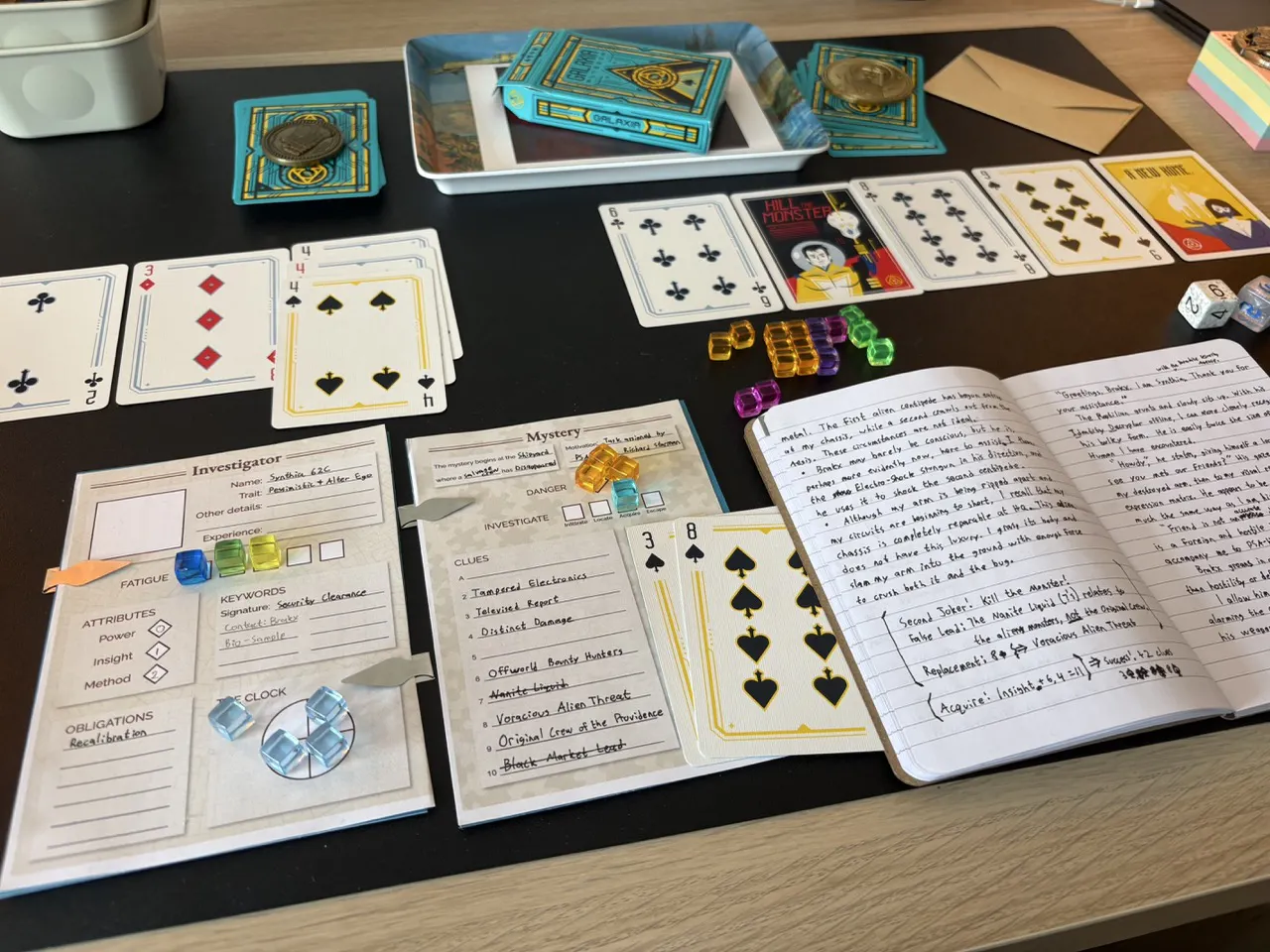 (Opens in a new window)
(Opens in a new window)The “You” Detective Agency
Caught in the Rain is, first-and-finely, a Singleplayer Roleplaying Game about Noir-style fictional investigators. The PDF comes in at over 100 pages, and even with large type, several full-page illustrations, and a significant page count devoted to oracle tables, the game is complete, meaty, and definitely shelf-worthy once the physical edition ships.

Singleplayer Roleplaying is seeing a big rise in recent years. From Ironsworn (Opens in a new window) and Starforged (Opens in a new window) to Elegy (Opens in a new window), from Cartograph (Opens in a new window) to Artefact (Opens in a new window), from Galatea (Opens in a new window) to Thousand Year Old Vampire (Opens in a new window), indie game designers are having a field day right now creating new storytelling games designed for a single player to enjoy. It’s no wonder why. In a singleplayer game, there’s no coordinating a calendar with five other adults, no players calling off sick last-minute, no waiting-two-weeks-between-sessions, and no expensive twenty-book expansion modules to keep up with the latest builds and monster stat blocks.
In Singleplayer RPGs there’s usually an inciting incident: an event, a scene, a story prompt. Then, you fill in what comes next. You read the prompt, you answer it — in whole or in part. You set a quest for yourself, you manage your resources, you roll dice to determine whether you succeed or fail. And if you don’t like something, you can change it — there’s no GM to say what you can or can’t do, and no party of players to try and convince.
Caught in the Rain provides the framework you need to tell a Noir mystery, even if you have no idea where to start. You get to fill in the blanks, you get to do the legwork (or at least, your character does), and you get to solve the mystery.
Noir Storytelling
One thing I love about CITR is how it handles the Noir framework for you, even if you’re not actually all that well-versed in what Noir even is. Sure, I had ideas when I first read about it. Mysteries? Whodunnit? Isn’t that hard to pull off in a game?
Yes, actually. It’s real hard. And designer-writer Nicholas Robinia did it.
“Noir” is a big and distinguishing keyword for Caught in the Rain. Noir stories are often themed around cynicism and fatalism (Opens in a new window): people act in their own best interests; and, respectively, events are predetermined from there. X begets Y. The man was shot, because he was a witness. The gun was warm, because it was just used moments ago. The madam was found cheating, and had the means to hide it. So she did. And now a man is dead, and there’s an entire dinner party’s worth of suspects.
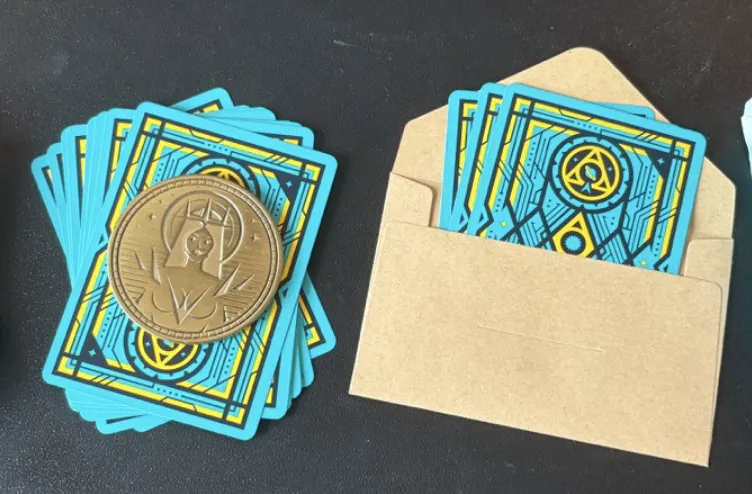
The suspense builds from the first moment — and you, the player, get to enjoy it.
Caught in the Rain is the first TTRPG I’ve seen that focuses on helping a player tell a Noir investigation rather than a Weird investigation. In Weird fiction, the past is nebulous and even malleable to give way to new discoveries later on. But in Noir fiction, time is linear and history is concrete, whether you’ve learned about it or not. In Noir, you can’t change the past, you can only view it in a different lens.
How Mechanics Tell Stories
In any good investigation journey, there is some element that spawns the mystery. There are many suspects, many possibilities. One of them is true, and that truth is true, not because it might have been true but because it was true all along. That truth is discovered by examining clues and ruling-out false possibilities, which can only be done by gathering multiple forms of evidence and building a case.
In a very literal sense, when you first sit down to play Caught in the Rain, that Truth is both established and also hidden from you, the player. During setup, you draw some cards and set them purposefully away from yourself, not unlike the envelope in the old Clue boardgame.
The truth lies tantalizingly within reach the entire time you play, begging for you to solve it and make the big reveal. The suspense builds from the first moment — and you, the player, get to enjoy it.
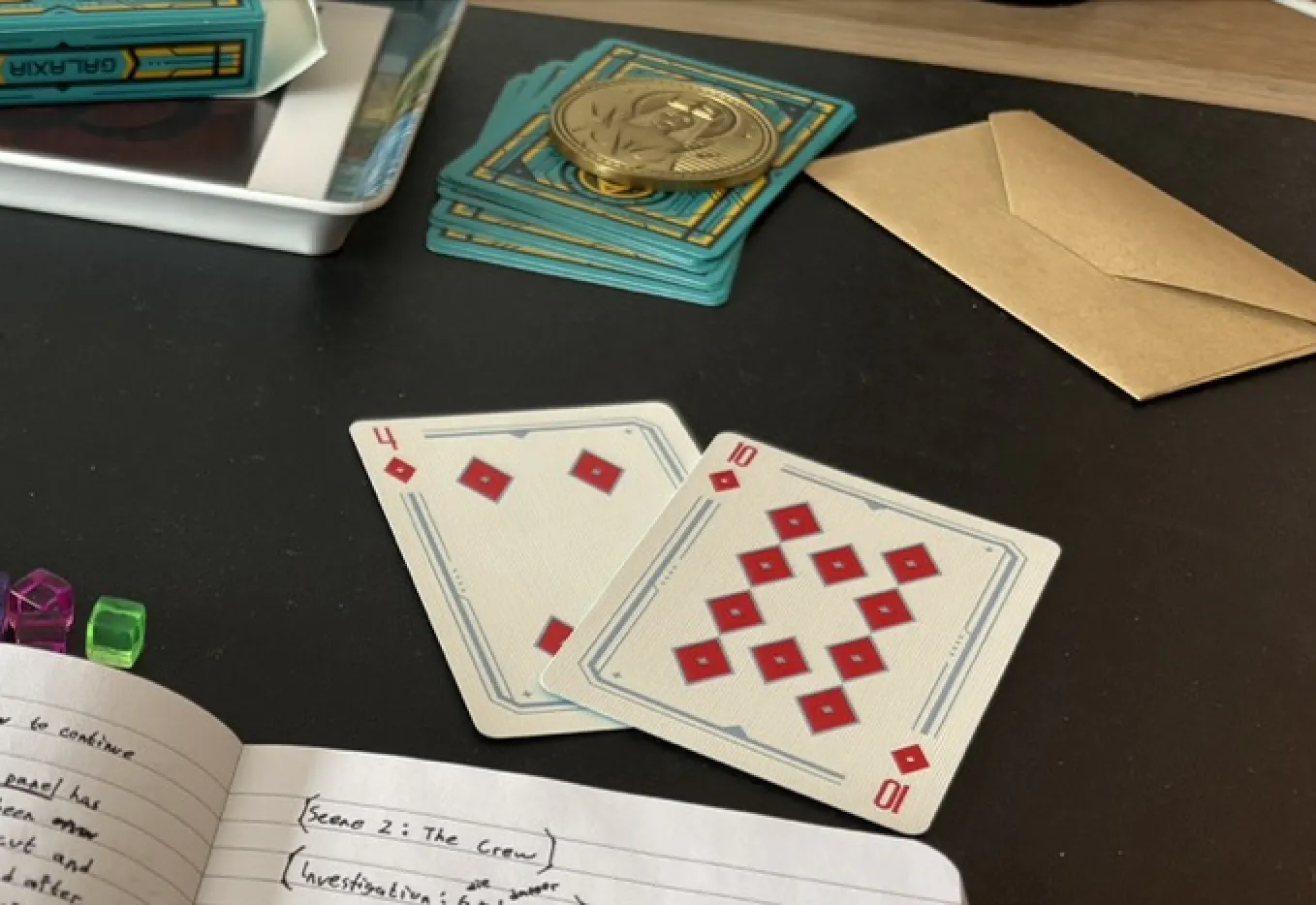
Now, let’s talk about investigations. And for that: scenes.
A scene is a grouping of events that come together frame parts of a story. They typically have boundaries at the edges of something interesting or novel. It’s not fun to follow the investigator through every minute of their day, so instead, you pick out a few interesting highlights to the investigation, then frame a context to prop up the event — and then you play it out.
The gun was a Smith & Wesson Model 327, so I want to investigate the local gun shops to see if anyone knows who it was sold to.
The victim owed the Jamesons a lot of cash, and maybe they thought it was time to collect. I should question Mr. Jameson on his thoughts and statement about the murder.
The butler saw a woman in a red dress slip away from the party, but he couldn’t identify her face. I should ask the suspects and find out who remembers red dresses.
In game terms, these events translate directly into Investigation scenes, which are the primary way the player gains Clues, which you use to solve the mystery (more on this later).
Sometimes, the path isn’t clear, and/or, you have to infiltrate to sneak in. Sometimes — especially as the story progresses — the tension gets higher, and you start encountering more and worse threats. Sometimes there are even False Leads, where information you thought was a significant clue is only tangentially relevant. Like how Mr. Jameson might have been owed money, but the victim has been making all of his payments on time. Since Mr. Jameson can’t collect any money from a dead man, that motive is a bust; the lead, a dud. But the majority of your Clues will be decent, and the best ones become your most promising leads, and promising leads are how you crack the case.
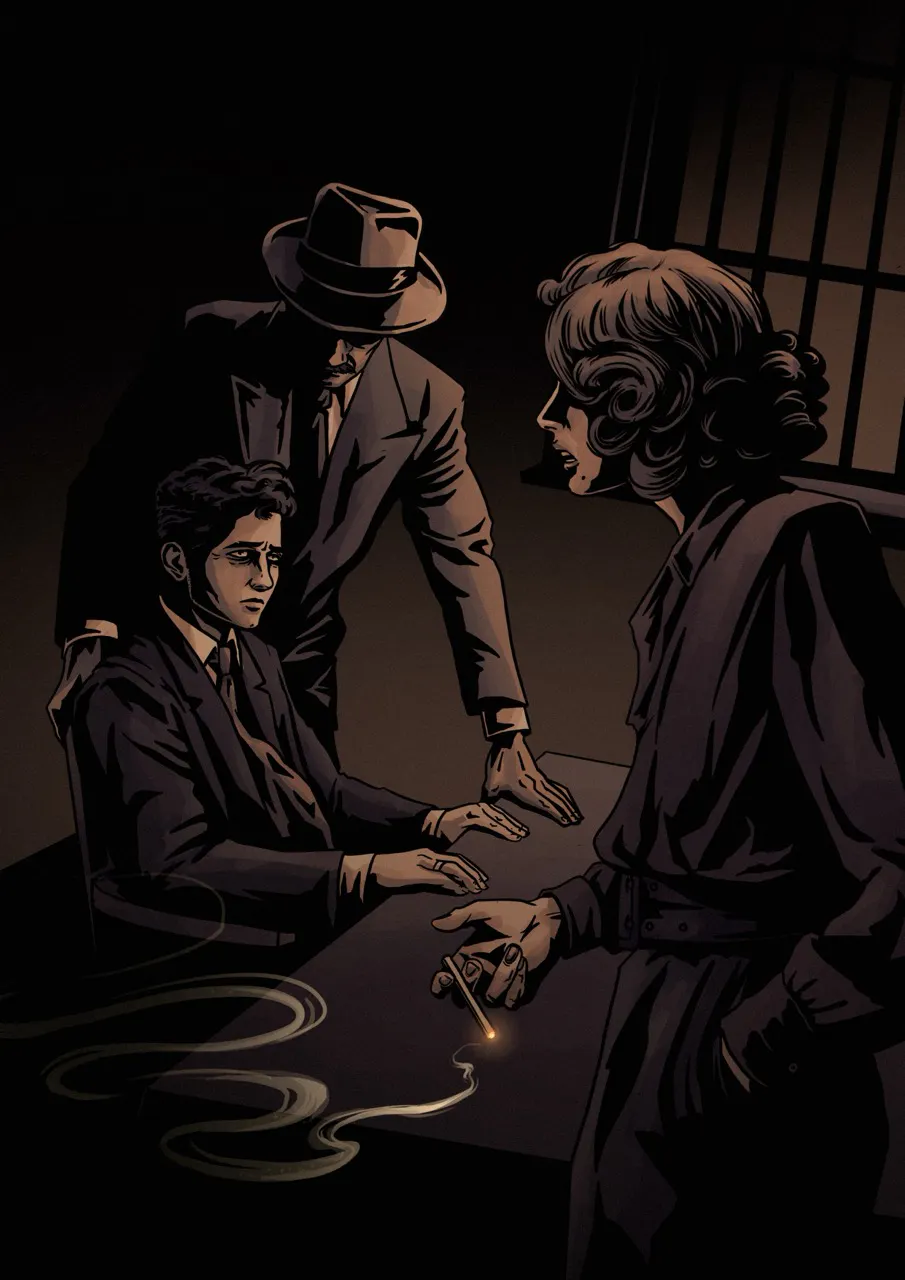
During an Investigation scene, the player will make a series of 1d6 and 2d6 dice rolls, for which you pick a stat and roll to succeed. The resolution is typically pretty simple: 1d6 are lookup charts, and 2d6 is used for Attribute Tests which follow a simple 3-degrees-of-success resolution mechanic (much like in Powered by the Apocalypse and other modern 2d6 systems).
The Character has three attributes, typically ranked at 0, +1, and +2 in any order. For a given attribute test, you pick the most relevant stat and add it to your roll to arrive at the outcome. If the dice show a [6] and [2], you’re going to succeed on any check, but you’ll only critically succeed for your +2 attribute. For Method, perhaps to pick a lock or hack into a computer system. If Method is +2 but you’re trying to overpower a Threat with force, you’d still succeed, but you’ll also suffer a Consequence, too, which adds narrative pressure.
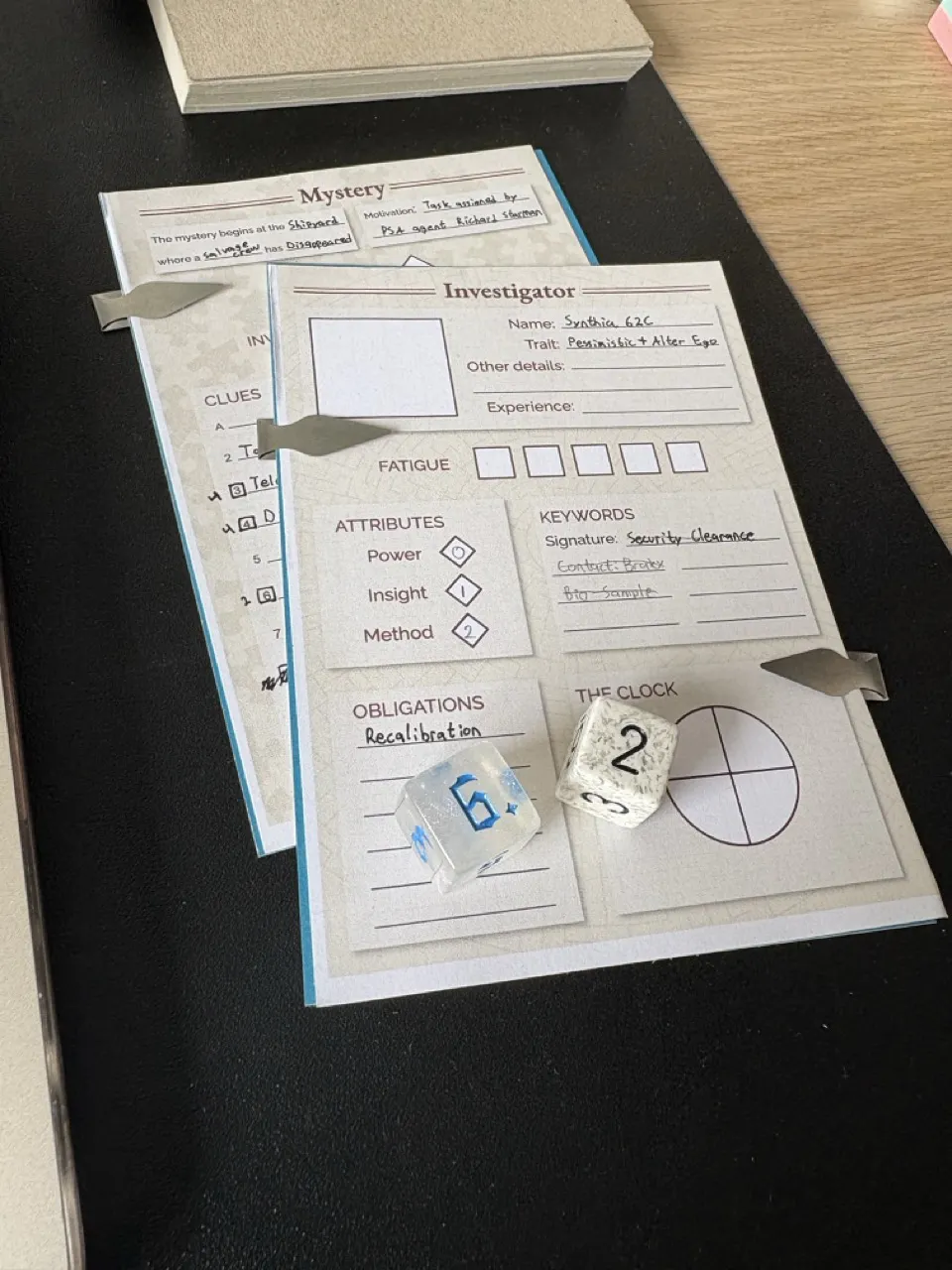
It’s here that I’ll point out a subtle flaw in many singleplayer RPG’s with stats. Generally, a Character will approach a situation in a way that suits them best, and since the Player typically wants to advocate for their own Character, it’s easy to end up phrasing the narrative so that you roll your best stat all the time.
And it’s here, that I’ll point out how Caught in the Rain flips that around a little: Failures also come with a powerful consolation incentive in the form of Keywords, which can serve as wildcards and get-out-of-jail opportunities for later. You can use Keywords to reroll dice, make threats go away, or bolster your most-promising leads. This means that, in some ways, it’s actually easier to solve the mystery when you fail a few rolls. Failures make the situation more tense by marking fatigue, introducing or emboldening the active Threats, and even discarding Clues permanently — and then the Keywords help the character still make progress in the story, giving the player a powerful resource they can use later.
It's an interesting take on “Failing Forward”, the concept that even bad die rolls lead to interesting narratives and towards progress. Put another way, no roll is ever boring.
Gathering the Evidence
Scenes help frame narrative slices of play, but they serve the purpose of helping get your investigator closer to the answer. In doing so, you collect Clues, which you tangibly represent with the numbered pip cards of your deck.
During each Investigation, either during the Acquire stage or whenever you roll 10+ on an Attribute test, you collect Clues. The first time you encounter a 6, you either focus on something interesting that you’ve come up with, or, especially at the beginning, you can lean into an Oracle Table. Maybe it’s the handgun, or maybe it’s a smudge of red lipstick. Maybe it’s a butler saying he saw a Woman in a Red Dress, or a stack of unpaid bills.
The important thing is, every time you draw a 6, something in the fiction reinforces whatever clue that is. If the first 6 is a smudge of lipstick found on the victim during the first Investigation, then you later draw a 6 when questioning Mr. Jameson in his office, then there’s for-sure something damn interesting going on there. Now you have to explain why the lipstick is in his office, building up the fiction as you do.
On the mechanical side, this plays into a facet of random numbers. In a large enough data set — say, 42 out of 42 cards in the deck being drawn — every pip and both jokers will be revealed. But in a smaller data set, you will very likely encounter duplicates. You might see three 6’s before your very first 3; and when you already have six clues laid in front of you, any further draw is just-as, if not more-likely to establish a previous clue than to create a new one.
In fictional terms, math works in the investigator’s favor, because every clue tells part of the story, and every duplicate becomes fictionally significant.
Telling the Truth
When you have enough clues together, you use them to determine what really happened.
In game terms, the stated objective is to deduce the 3/12 face cards in the mystery. For the player, the goal becomes uncovering the other 9 cards and analyzing which faces are missing. There is no direct mechanical connection between which clues you investigate and which faces you draw, and there’s no fictional representation in advance as to what each uncovered truth means. So, Caught in the Rain offers advice on how to bridge that gap.
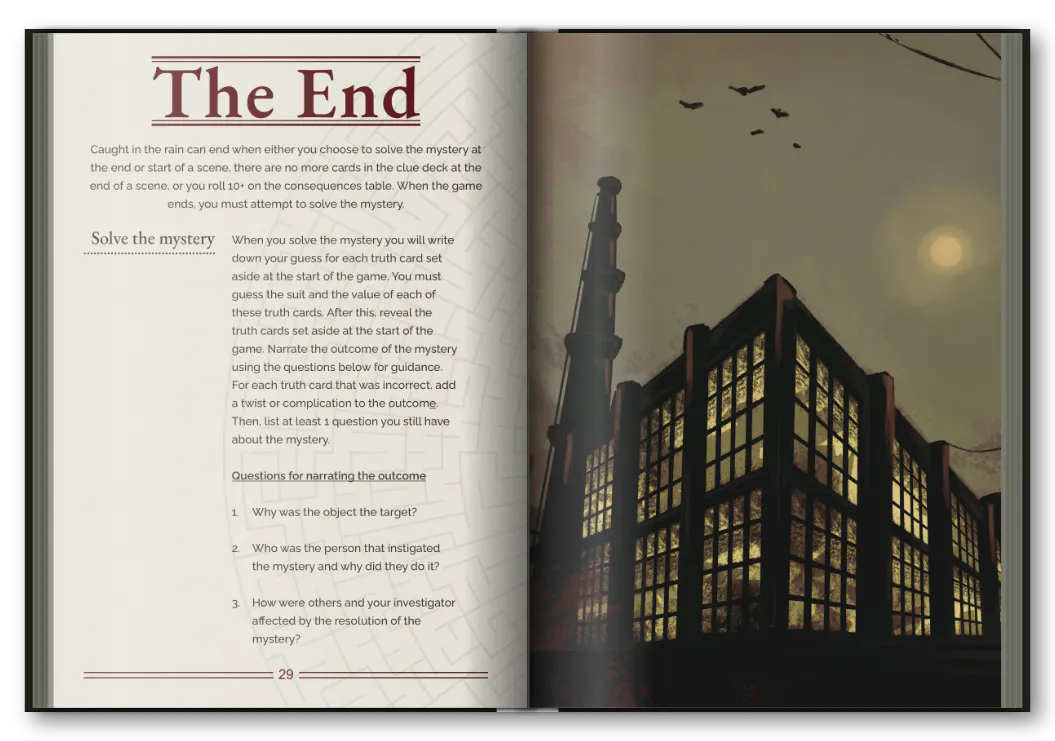
When I played during the playtest, this tripped me up a little. I wanted each face to have a meaning, and I was trying to figure them out in advance. Admittedly, this required some calibration on my part, and thankfully, the full game has guidance on how to make interesting Truths and how to turn them into a satisfying Solves at the end. By the end of my second game, I had a thrilling conclusion.
A stack of four 4’s is a hefty smoking gun when you only need 9 Truth cards total. You need a minimum of 3 different types of Clues, and each one tells important answers when you focus in on the evidence you’ve found surrounding that Clue.
The lipstick found near the victim and in Mr. Jamesons’s office was actually purchased by Mr. Jameson himself, who claimed it was a gift for his wife. However, his wife could never have received that gift because she’s out-of-town visiting her sister. Mr. Jameson claims to have believed it was still in its original packaging — but it definitely was not.
Do the gun next, and then the butler. And now you’ve got a pretty good understanding of What Really Happened — and you’ve got the cards to prove it.
Difficulty & Tension
To quote Blackway & Black Caviar, “I like hard chances that I might lose” (Opens in a new window).
Caught in the Rain does not embody that lyric in the slightest. But I don’t think that’s a bad thing. I actually think that’s one of its biggest strengths, because there’s a difference between Difficulty and Tension.
Stories rely on Tension. In many games, that’s managed by Difficulty: tough odds on resolution mechanics, weighed against player choices to try and nudge things in their favor. Ostensibly, the Tension comes from the perceived risk of total absolute failure.
Caught in the Rain doesn’t do that, however. Fatigue gives you an idea of how many times you can fail, and helps the player decide whether they can push their odds or not. But when it’s maxed out, you (usually) just transition towards ending the scene, and you can’t continue until you Rest.
That’s just one example out of several failsafe mechanisms to keep a player going, to help the player keep making progress. There’s little-to-no garbage time (Opens in a new window) to speak of, because the Clue Deck is rather large — you probably won’t run out unless you roll a natural 7 on pretty much every attribute test. And because you know exactly how many clues you need to solve the case, you can end the game at just about any time. You can add up the Clues you’ve drawn and the Keywords you’ve collected, and say “that’s it, I’m done”. You can switch from Investigation scenes into Truth scenes and be finished with dice rolls altogether as soon as you reach a certain threshold.
That choice is yours, which means you can wrap up the game and call it finished once you’re ready for it. And that feels pretty great.
Links:
Caught in the Rain is available on Itch.io today (Opens in a new window) and in print-preorder from the Ravensridge website. (Opens in a new window)
The Ravens also run a Discord server (Opens in a new window) where you can meet and hang out with more members of the community.
You can also find and chat with me on the Play Brilliant discord server (Opens in a new window)! I’d love to hear your thoughts.
Cards shown and the wide commemorative coin on display are designed by Giovanni @ Thirdway Industries (Opens in a new window). For my recent playthrough of CITR, I used the Galaxia Altezza (Opens in a new window) deck.
For more like this:
If you aren’t a subscribed member already, and would like to see more content like this, consider subscribing to the Play Brilliant newsletter! I aim for 2-4 posts per month, in which I discuss and review TTRPGs.
Additionally, paid members also get access to fully-documented Play Reports, plus handcrafted games I design each month, and the knowledge they’re supporting the indie TTRPG scene.
Made with fresh, all-natural ingredients! No preservatives!
Speaking of play reports, click here to follow the story of Synthia 62C (Opens in a new window), an investigation synth-droid in the Paradise Security Agency.
The Mystery begins at the Shipyard, where the Salvage Team has Disappeared!
Credits & Disclosures:
I backed CITR on Kickstarter with my own funds, and I’m thrilled with the delivery. I haven’t received or been promised any payment from Ravensridge for writing this article. All thoughts and opinions expressed are my own.
In playing this game, I extensively used a deck of cards purchased from Thirdway Industries, with photography permission from the artist. In return, Giovanni has generously provided me with a promo code on future purchases I make.
This article has not otherwise been sponsored.
If you would like to become a sponsor and/or see your work featured in articles like this, please reach out to me: nicole@play-brilliant.nl (Opens in a new window)
No AI technologies were used in the making of this article. Proud to be Human!


